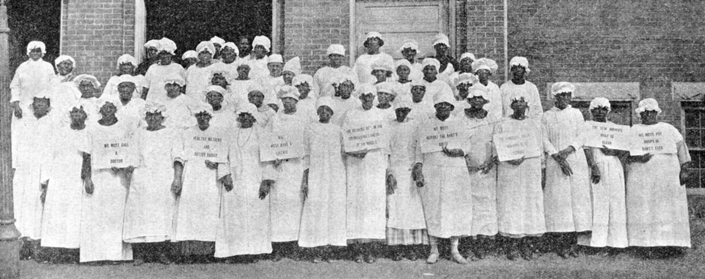Midwives
Midwives, who help expectant mothers through the labor process, lend emotional support, and attend the delivery, have been present in North Carolina since the arrival of the first English settlers. Most midwives in the colonial period received no formal training but learned through apprenticeship (often under their own mothers) and experience. Until the beginning of the nineteenth century, midwives were the primary birth attendants in North Carolina. Physicians became more involved in infant births during the 1850s; before then, a man's presence in the delivery room was prohibited due to modesty and moral taboos.
Initially, rural landowners used midwives to help with family and tenant births. As medical care evolved, wealthy North Carolinians began using professional medical personnel and traveling to hospitals to give birth. As a result, midwives serviced mainly poor, often black, mothers who could not afford a doctor. A midwife was often seen hurrying across town, toting a leather or cloth bag filled with birthing supplies (cotton pads, sewn sheets, clean newspapers, and a large knife or scissors).
In 1917, the year midwives were first licensed in North Carolina, 9,000 women were registered. In the 1930s the state government launched an effort to regulate midwifery, which resulted in a steady decline of registered midwives. This trend continued through the 1970s as medical professionals voiced their concern that the combination of poor, high-risk patients with minimally trained caretakers was dangerous to the patients' health.
A resurgence in the popularity of at-home births in the early 1980s led to a revival of the midwife profession in the state and nation. In 1983 North Carolina legalized nurse-midwifery and created a Midwifery Joint Committee to regulate midwives. It also approved Certified Nurse-Midwives (CNMs) to practice. Unregistered or lay midwives were not included in the legislation, although some continued to practice illegally.
By the early 2000s, 176 CNMs practiced in hospitals, university medical centers, clinics, birth centers, and homes across the state. Many expectant mothers preferred to use nurse-midwives because they spent more time with patients and did not administer drugs, making labor a more natural and holistic experience. The Charlotte area had the largest number of CNMs with 22, followed by Asheville/Henderson, 13; Durham/Chapel Hill and Greenville, 12 each; and Greensboro, 10. If problems or difficulties arose during labor, CNMs were required to call in their supervising physician, although the profession was trying to move away from such restrictions. Midwives rarely performed cesarean sections.
East Carolina University in Greenville offers a master's degree in nurse-midwifery. Although it remains a female dominated profession, some men have become CNMs.
References:
Michael Cory, "Midwives Still Labor under Misconceptions," Business North Carolina (January 1999).
Manual for Midwife Practice in North Carolina (1969).
Patrick R. Ninneman, "Midwives in North Carolina" (M.A. thesis, UNC-Chapel Hill, 1996).
P. Radochl, "Midwives in the United States: Past and Present," Population Research and Policy Review (1986).
Additional Resources:
North Carolina Friends of Midwives: http://www.ncfom.org/hominc.html
Guide to the Mary Elizabeth Weston Papers (a North Carolina midwife, 1900-1918, 1944 (Manuscript Collection #626), Joyner Library, East Carolina University: http://digital.lib.ecu.edu/special/ead/findingaids/0626/
Search results for 'Midwives' in the North Carolina Department of Cultural Resources Digital Collections
North Carolina Midwives Alliance: http://www.ncmidwife.org/ncma-Legislation.html
NC Midwifery Licensing Act Licensure: http://www.ncga.state.nc.us/documentsites/legislativepublications/
1 January 2006 | Mobley, Sarah
